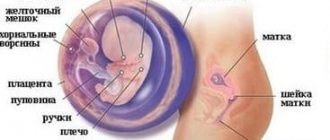Pregnancy is one of the happiest and most enjoyable periods in the life of every woman. And it is not at all surprising that every woman looks forward to childbirth - an exciting moment that only separates the expectant mother from meeting her baby for a while.
But quite often during the process of delivery certain problems and difficulties may arise, for example, if the cervix is ready for childbirth, but there are no contractions. What to do in such a situation and how to speed up the birth of a child?
The importance of the cervix in childbirth
The uterus is the central link in the female reproductive system, without which it is simply impossible to become pregnant and give birth to children. It consists of several components - the neck, bottom and body. It is the condition of the uterine cervix that determines how the process of bearing a child and his birth will proceed.
Visually, the cervix is a kind of tube that connects the uterine organ and vagina with the cervical canal located inside it. A healthy organ is characterized by an elastic consistency and a tightly closed cervical canal, thanks to which the fetus is securely held in the uterine cavity.
The opening of the cervix during childbirth is a normal phenomenon that allows the baby to be born. But in some cases, this symptom can also occur during pregnancy, which indicates the development of certain pathologies of the female reproductive system:
- cervical erosion;
- complex surgery, severe complications, rupture during a previous birth;
- isthmic-cervical disease;
- presence of miscarriages, history of abortions.
Regardless of the cause, premature dilatation of the uterine cervix poses a serious danger to the baby and often causes miscarriage or premature birth. The cervix should open immediately at the moment of birth.
When is it time to go to the maternity hospital?
If real contractions begin before childbirth, it means that labor is approaching. Don't worry, you have time to calmly collect yourself while contractions occur at intervals of 20-30 minutes. Of course, it is advisable that the bag with things is already collected in advance.
The last weeks of the third trimester of pregnancy are a time of exciting anticipation for the expectant mother.
One of the most interesting questions for a woman is how contractions will go before childbirth.
Contractions are the surest signs that the baby is ready to be born.
Prenatal contractions are not at all similar to training contractions (Braxton Higgs contractions, which a pregnant woman has probably already encountered).
In case of real contractions, you need to act immediately. We'll look at how exactly next.
The process of dilation of the uterine cervix
The first indicator that a woman’s body is completely ready for childbirth is the full maturity of the cervix. During pregnancy, the uterus and cervical canal are tightly closed to reliably protect the baby.
Immediately before childbirth, the cervix begins to actively change; as a result of numerous physiological processes, most of the muscle tissue is replaced by connective tissue. As a result, the uterus and its cervix become softer, more elastic and pliable.
As a result of this process, the uterine cervix begins to actively shorten, soften and loosen, and the lumen of the cervical canal increases. But in some cases, the reproductive organ does not expand even when active labor begins. In such cases, additional stimulation of labor is required.
Possible problems
Problems with dilation of the cervix during active labor may be associated with the psychological mood of the expectant mother, as well as her panicky fear of the upcoming birth. Thanks to this psychological barrier, a disruption in the normal hormonal balance occurs in a woman’s body, and as a result, contractions begin, and the uterine cervix is completely unprepared for childbirth.
Also, the reasons for insufficient maturity of the uterine cervix before childbirth include:
- Polyhydramnios.
- Low water.
- Dysplasia or deformation of the uterus.
- Loss or prolapse of an organ.
- The age of the first-time mother is over 35 years.
The most severe cases are those in which the cervix was previously removed as a result of various diseases. To remove part of the reproductive organ, conization is used, that is, a cone-shaped excision of the uterine cervix or cryodisruption, which is the effect of liquid nitrogen. Most often, the main indication for such an operation is cancer.
If a woman does not have a cervix, plastic surgery or bougienage is often used. These operations are carried out to restore the normal anatomical structure of the reproductive organ. You need to make a decision together with your doctor about how effective and optimal this method of restoring the condition of the uterine cervix will be.
Many women wonder - if there is no cervix, what to do and how can you give birth to a healthy and full-term baby? In such cases, the patient should be under constant medical supervision. A doctor who monitors a woman during pregnancy necessarily refers her for diagnostics.
Biopsy and colposcopy are considered the most accurate and informative. As a result of these studies, the doctor receives the most detailed information about the state of the reproductive organs in the female body, as well as about the recurrence of a cancerous tumor.
Ways to stimulate the cervix
What to do if a woman’s cervix is completely ready for childbirth, but contractions still don’t start? Only a woman's doctor can tell you the answer - it is he who will select all the necessary medications and suggest home remedies to help stimulate labor.
There are a number of medications designed to activate the process of dilation of the cervix and intensify labor. Such medications are injected into the cervical canal, the effect can be expected within 2-3 hours.
Treatment of a narrowed cervical canal is carried out using kelp, a medicinal product that comes in the form of sticks. Such sticks, saturated with moisture, are introduced into the cavity of the cervical canal, where, under the influence of time, they begin to gradually swell and increase in size, leading to an expansion of the canal. As a rule, 3-5 hours of using kelp is quite enough to prepare the cervix for childbirth.
Prostaglandin in the form of a gel or suppository - within a few hours the woman’s body is completely ready for childbirth.
In the most severe cases, an amniotomy can be performed in a hospital hospital setting - this procedure is a medical puncture of the amniotic sac. In this case, the water breaks, the baby’s head drops, and labor accelerates.
Non-medicinal methods of activating labor activity of the uterine cervix:
- sexual intercourse - just one sex can provoke a noticeable contraction of the muscle fibers of the uterine organ, which activates labor;
- cleansing enema - has an activating and irritating effect on the walls of the uterus, provoking accelerated contraction of the organ;
- physical activity - of course, no one forces the expectant mother to do strength training; it is quite enough to constantly walk around the ward or in the corridor of the maternity ward.
The cervix and indicators of its maturity play an extremely important role in the process of childbirth. If the uterus is ready for childbirth, but there are no contractions, various methods of quickly stimulating labor are used. These include medications as well as other methods. All this will help the birth of a healthy and active baby.
Deadlines
Regardless of whether the pregnancy is pathological or not, it is important to notice the process of rupture of the amniotic bladder. This can be expected at different times.
At what point does your water break?
When the uterus is ready to begin labor, the amniotic sac bursts. In the period from 32 to 37, as well as after the end of 42 weeks, there are serious risks of complications during childbirth and a threat to the health of the baby. It is forbidden to manage without doctors in this situation.
Differences in onset time:
- prenatal;
- timely;
- lingering.
Prenatal effusion. In the period before 37 weeks, rupture of the amniotic sac is called premature and carries the risk of serious complications. The degree of danger depends on the duration of pregnancy and timely hospitalization.
Consequences:
- umbilical cord entanglement;
- malposition;
- death due to physiological prematurity.
Labor does not occur in the early stages, so urgent surgical intervention will increase the chances of a successful outcome. To avoid bad developments, you need to eliminate risk factors.
- ignoring leaks;
- hit;
- injuries;
- exacerbation of chronic infections;
- excessive physical activity;
- severe stress.
Timely outpouring. In the absence of pathologies, by the 37th week the uterus is ready to let the fetus through, the organ becomes softer and open by 3.5-5 centimeters. The gradual release of water should begin before the end of 42 weeks, due to the natural rupture of the amniotic sac. Contractions should begin at the same time or within the next 10-12 hours.
Prolonged effusion. In approximately 10% of women in labor, the water does not break on time. In this case, an amniotomy procedure is prescribed - puncture or rupture of the amniotic bladder. With the right medical approach, the procedure goes well, without consequences.
There is a method for pregnant women to speed up the process of labor and water breaking. Slow, constant walking increases the speed of the onset of labor by 30%.
How to speed up the discharge of amniotic fluid:
- special medications sold without a prescription in pharmacies;
- eating fresh pineapple;
- light physical work;
- sexual contact;
- nipple stimulation.
Doctors insist not to stimulate the process on their own. If necessary, the obstetrician will perform the puncture operation in the hospital on time.
What does an immature cervix mean?
An immature cervix is an organ that is softened or, on the contrary, too dense. The length of such a neck has not decreased in length and is 3 or more centimeters. It can be completely closed, or have a slight opening with a slope back.
One speaks of a mature person when she:
- shortened to 1-1.5 cm;
- located clearly in the center;
- opened well, one or two or more fingers freely penetrate into the canal.
Only a specialist can determine the condition of the organ after examining the pregnant woman in a gynecological chair.
What to do if your water breaks
A woman’s behavior in a situation where her water has broken should depend on how far along in pregnancy she is, as well as on how much fluid was released and what kind of fluid it was.
If a woman is 37-41 weeks pregnant and her clear water has broken By a small amount we mean a volume of liquid approximately the size of a glass - 200-250 ml. Sometimes in courses for expectant mothers, pregnant women are advised to “rehearse” the release of amniotic fluid in advance, so that when the time comes, the woman can understand how much fluid has spilled out. To do this, experts advise taking a glass of warm water, standing in the bath and pouring the liquid onto your feet. Remember the sensations. Then pour a one and a half to two liter jar of water over yourself. Such a rehearsal will help you understand, when the time comes, how many waters poured out at one time. If the amniotic fluid literally gushed out, you should hurry to the maternity hospital.
You should go to the maternity hospital as quickly as possible even if your water is brown or green. To ensure that the color of the gushing water is obvious, doctors advise pregnant women to wear light-colored underwear and use white sheets for sleeping in the last weeks before giving birth.
Premature rupture of amniotic fluid is a dangerous situation and in this case the woman needs urgent medical attention. When amniotic fluid flows out at 20-24 weeks, the probability of miscarriage is very high. If it was prevented, the pregnant woman is given drugs that protect the fetus from infections and promote its further development. In this case, the expectant mother will have to observe strict bed rest until the birth.
If the water breaks at 24-28 weeks , then, if you seek medical help in a timely manner, the chances of preventing premature birth, protecting the fetus from infections and stimulating its ripening are quite high.
At a period of 28-32 weeks, in the event of rupture of amniotic fluid, doctors make a decision on whether to continue the pregnancy or perform a premature delivery after examining the pregnant woman. It all depends on the condition of the expectant mother and the fetus. After the 32nd week of pregnancy, the rupture of amniotic fluid in most cases ends in childbirth, or doctors perform delivery through a caesarean section.
Causes of an immature cervix at 39-41 weeks of pregnancy
The main causes of this pathology include:
- disorders of the nervous and endocrine systems;
- diseases related to metabolism;
- congenital anomalies of the genital organs;
- inflammation in the reproductive organs;
- hyperextension.
In addition to the main reasons, uterine immaturity at 41 weeks may be associated with the presence of fibroids, a large fetus, obesity, polyhydramnios, or a tumor in the pelvis.
To prevent such deviations, you need to promptly treat all diseases of the reproductive organs, lead a moderately active lifestyle during pregnancy, be less nervous, monitor weight gain, and constantly see a gynecologist.
How to prepare the cervix for childbirth?
If the cervix is not ready for childbirth, it needs help. Sometimes the birth process is brought closer for medical reasons if a woman has gestosis, heart problems, or the baby has hypoxia.
There are several ways to help prepare the cervix. This can be done using:
- a set of Kegel exercises;
- folk recipes;
- kelp sticks;
- medications.
A woman can use some at home, some can only be used in the presence of a doctor in a hospital setting. Let's look at each in detail.
Set of exercises
Initially, gymnastics is performed in a sitting or lying position. Each exercise should be repeated three to five times. Gradually the numbers increase to 15-25 times. This amount does not need to be completed at once. This is done throughout the day.
- Lie on your back or sit on the sofa or floor. Bend your knees and open them. Tighten your vaginal muscles and hold for about ten seconds. Then relax.
- Imagine that your vagina is a multi-story building. You take the elevator down from the top floor. This way you tense your muscles and relax them. The tension on the top floor will be the strongest, and will weaken downwards.
- We train vaginal and anal muscles. Initially, the muscles of the vagina are in tension, then the anus. Relaxation will also take place alternately.
- While sitting or standing, try to strain as you would during a bowel movement, but also use your vaginal muscles.
To have a positive result, all the exercises presented must be done several approaches every day. In addition, you should walk, climb stairs and wash floors while squatting. But the latter should be discussed with your doctor. Excessive physical activity can cause various complications.
Folk remedies
The opening of the cervix is facilitated by sexual contact. Male semen also contains special substances that stimulate the birth process.
In folk medicine there are several recipes, using which you can prepare the cervix at 41, 40 or 39 weeks of pregnancy. It is not recommended to use any of these without consulting a gynecologist.
- Raspberry foliage. A decoction is made from dry raw materials. 30 g of crushed leaves should be poured into 800 ml of water. We wait for it to boil over low heat. Afterwards, under the lid, you need to leave it to infuse for 2-3 hours. From 38 weeks, take 300 ml in three doses.
- Rose hip. An infusion is made from the dried fruits. Take 100 g of raw materials and 800 ml of boiling water. You need to leave it for three hours. After 37 weeks, it is recommended to consume 150 ml on an empty stomach in the morning.
- Hawthorn. A pharmacy tincture is used. For 10 kg there are two drops of the product. The liquid is first diluted with water. Drink twice a day, half an hour before meals. The optimal time to start using hawthorn is 40 weeks of pregnancy.
- Immature cervix before childbirth? Use strawberry infusion. You need to take about 100 g of berries, 40 g of chopped leaves and 1 liter of water. Cook for 40 minutes after boiling. After cooling, strain and add a little honey. This composition should be drunk throughout the day. Treatment begins at the 38th week.
All folk remedies can become dangerous if used without a doctor's permission and in unacceptable dosages.
Kelp sticks
The ripening of the cervix is promoted by kelp sticks introduced inside. Outwardly, they look like a thin stick, but when they come into contact with moisture, they increase several times in size. To place them in the cervix, a woman comes to the gynecological office and lies down in a chair. During insertion, pain and discomfort are felt. After a certain time, the kelp grows and puts pressure on the canal. During this process, the woman begins to experience contractions and pain in the abdominal area. All this is complemented by copious discharge from the genital tract. Thus, the genitals are prepared for childbirth.
Medications
Doctors often use drug therapy. If the organ cannot mature due to muscle strain, then antispasmodics are prescribed. They help relax muscles, eliminate pain and enable the cervix to ripen more quickly. Most often prescribed:
- candles containing belladonna, papaverine or buscopan;
- tablet form;
- injections;
- mifepristone.
All medications can only be used under the supervision of a physician.
Sometimes a gel solution containing prostaglandins is used. It is injected into the cervical canal, after which the walls soften and become relaxed.
It cooks the neck well, evening primrose oil. It should be taken every day, one capsule. This product contains a lot of acids, which contribute to the production of prostaglandins. The oil cannot be used without the permission of a specialist.
Examinations in a chair facilitate rapid dilation of the cervix, but this is not used, as there is a risk of infection.
BabyMother
Long cervix before childbirth, what to do
40 weeks, I saw the doctor yesterday, he says my body is ready for childbirth, but my cervix is not! Has anyone experienced labor under these conditions?
Hello girls! Yesterday I had an ultrasound, everything is fine with the baby, we are growing! But the doctor focused on the length of the cervix, or rather asked the nurse what the length was at 12 weeks, but so at 12 weeks...
Cervical length
I am 29 weeks and 2 days, cervical length is 30.5 mm. I looked at the standards on the Internet - this is not enough, doctors say - the norm is up to 25 mm. And I myself am worried. Suddenly it continues like this...
"Long cervix"
The other day I reviewed last year’s tests, including GHA. Upon conclusion, the pipes are passable. But I suddenly remembered how during the procedure the doctor dropped the following phrase: “You have a long cervix, it will be difficult for you to give birth...
cervical length
At 18 weeks, ultrasound showed the length of the cervix was 24 mm. The ultrasound specialist didn’t say anything, but G. yesterday said it’s sooooo short! I asked if there had been any interruptions in the past. But this is my first pregnancy, before pregnancy...
Cervical length
Girls, maybe someone has encountered such a question. On ultrasound they constantly tell me that my cervix is 34 mm. This seems to be one mm less than the norm)). That's why I show up to my doctor every week in the chair...
cervical length
Hello everyone! I had an ultrasound today, but I went because I’ve been feeling some discomfort inside for a couple of days now, it hurts in the cervical area, it shoots, or something else, in general it’s not comfortable. They scared me with the shortening of the cervical spine, so I'm scared...
cervical length
2 weeks ago it was 39 mm, yesterday it was 32 mm, the doctor says everything is ok! I don’t know how it is here, but in Russia, when it is less than 30 mm (as well as throughout the world, I read this on...
Cervix…
Today I’m 11+1 weeks, I went to take a smear, the doctor said that the cervix was short and asked if district police officer G had told me about this. She felt something on the palate)) and said that the cervix was about 3cm, that everything was closed, everything was fine, Just…
Does everyone have their cervical length measured?
Hi girls! Tell me, I’m almost 20 weeks old and the last time I had an ultrasound was at 12 weeks, before that every 2 weeks and I’ve never had my cervix measured. After calling my fertility specialist about canceling...
Damn, everything was going so well... Today I saw the doctor. The cervix is oak. Gives me until Monday, and then to the hospital. I really wanted to give birth myself, but now I don’t know what to think, damn it. The first birth was terrible. This time I decided that there would be no intervention from doctors. I got ready, went to gymnastics, went to the pool, ate properly, spent the entire pregnancy in the fresh air, how many kilometers did I walk, how much did I move... I signed a contract for a natural birth with a midwife. And here you go... It’s time to give birth, but she, you see, is not ready. Crap!!!
Just yesterday, during the course, the midwife talked about the miracles osteopaths work. I haven’t tried it myself, to be honest, but she told it so impressively... Maybe read about this topic, what if???
I'll calm it down a little, I guess. At 40 weeks the cervix was not ready and did not open. They put me in the RD, they gave me a week to walk there, they wanted to stimulate me. At the appointed hour X, the doctors did not get around to me, they left me for another 2 days until the end of the week. She gave birth on her own, without stimulation, at exactly 41 weeks. The CMM opened within an hour. The birth after puncture of the bladder lasted about 2 hours. You should have seen the eyes of the RD medical staff at that moment.)) The first labor was induced for 12 hours + epidural, it’s still scary to remember..
Don't be upset, there's no reason
Give yourself and your body time, after all, these PDA dates are so transparent! Well, you haven’t been walking around for a month? I’m joking, of course, about the month, but it seems to me that since everything is fine, you treated the pregnancy correctly
Everything will happen on its own when the time comes!
Eh... I’m in either my first or second birth - my waters have broken, my cervix is barely one finger wide, and there’s almost no dilatation
... both times I gave birth with stimulation
, for a long time. One joy is that it is intact - not a single seam. The first birth was already at 42 weeks.
I had an appointment with an osteopath. He crushed me all over. He said everything was fine, no problems, we could give birth. No need to come anymore...
But they don’t let me reach the 42nd week. The doctor said that if nothing changes at 41, he will induce labor. Either this or the contract will be terminated. Damn, why the hell do I need this contract? For my money? There are people walking around for free, and no one bothers them. When labor began, we went to the maternity hospital and that was it. But on the other hand, this is also scary. The child is growing, and when she - this neck - deigns to soften - that is the question. My ultrasound already weighs about 3700. But I couldn’t push the first one, which weighed only 3150, on my own. It didn't bother me. The choice, of course, is mine. Just what to choose, and how not to make a mistake???
Well, you're in luck. But I certainly need people not to interfere. This was initially the whole calculation and attitude. Only the body fails at the most crucial moment. I gave birth to my first at 40 weeks minus one day. Labor started on its own. Within two days I had training and the plug came off. Everything is as it should be. And here…
But I wasn’t whole after my first birth. And there was a cervical rupture and episiotomy. That's why I don't want to go to bed. Again, they’ll ruin everything with their fucking stimulation.
Don't be upset. Sometimes things happen quickly. At 40 weeks, my cervix was also so bad that they said I would definitely have another week, or even two. And in the evening, labor began and dilated within three hours of contractions. So go figure that neck, it needs to be cooked, otherwise it’s suddenly ready. And there must be indications for stimulation; ask your doctor for them. Ultrasound weight is not accurate, I was always predicted to have large children, but everyone was born with a weight of 3200-3400. Why didn’t you feel any pain the first time?
My first ultrasound at 35 weeks weighed 3600. And at 37 he was born 3110
So don't worry too much about your weight. (By the way, my friend gave birth the day before yesterday at 41+1, and her cervix was also not ready until late).
You must trust the doctor if you choose him. Well, at least find out what’s bothering her, why she recommends stimulation. You can’t say so unequivocally that they just want to stimulate you. During my second pregnancy, I had to induce labor, the doctor monitored the baby’s condition day after day and waited until labor began, then she said “it’s time, it’s too risky to wait any longer.” The baby was born with signs of postmaturity and the placenta was heavily calcified, although the term was 39 weeks.
They began to grieve early. PDA is very approximate, and then today the neck is oak, and tomorrow it’s birth
Yes, and let me also remind you about a good natural way to stimulate labor - sex
))
Well, in general, until the 42nd week you can sit quietly and not rock the boat
Nonsense on vegetable oil. I gave birth at 41.5. In general, many pregnancies last 42 weeks, and not 40, as is commonly believed. We need to look at the maturity of the child and the placenta, and not focus on some numbers. I wouldn't stimulate anything until 42 weeks. Monitor via ultrasound, but there is no need to climb ahead of schedule. The child will decide for himself.
Ekaterinburg
Mother
Girls! Question! I'm 40 weeks old, my gestational age is 26-27. I'm in OMM. During the examination, they said that the cervix was not ready. They said that if by Monday or Tuesday the cervix itself was not ready, did not soften, they would give some kind of magic pill to soften the uterus. Has anyone encountered something like this???? Is it necessary to insist on natural delivery, or is this a kind of pathology???? Need some advice.
Life is good!!!
Ekaterinburg
Mother
I was given this pill to my sister, but nothing happened
At 41-42 weeks she had a CS, the doctor said that her cervix was not ready and that she had a cervix that would never ripen (I don’t know why)
and thank God they did the CS on time, because the child was very post-term and then they might not have been saved at all
It's up to you, but check with your doctor about the risks.
They do ultrasound in Omm
Ekaterinburg
Mother
Right now, she’s not ready for everyone, according to my statistics, out of 6 friends, 2 gave birth normally, 4 are healthy girls and all of them had an emergency caesarean section, since the uterus did not dilate, they stuff us with all sorts of garbage, and then we can’t give birth, they tormented me with everything, They induced labor, but still had to have a caesarean section, so I don’t know, it’s better to soften it the way they want, if you’re already lying there. They can’t lie there for more than 2 weeks, if you don’t give birth, then you have to call, and they don’t give a damn about anything. IMHO it’s too early, the deadline is not set correctly, you just have to wait, and everything will be fine. Have a healthy birth and baby!







